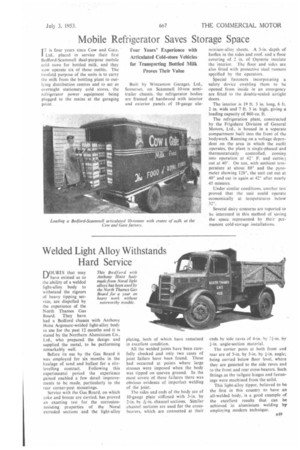Mobile Refrigerator Saves Storage Space
Page 107

If you've noticed an error in this article please click here to report it so we can fix it.
Four Years' Experience with Articulated Cold-store Vehicles for Transporting Bottled Milk Proves Their Value
I T is four years since Cow and Gate, Ltd.. placed in service their first Bedford-Scammell dual-purpose mobile cold store for bottled milk, and they now operate six of these outfits. The twofold purpose of the units is to carry the milk from the bottling plant to outlying distribution centres and to act as overnight stationary cold stores, the refrigerator power equipment being plugged to the mains at the garaging point.
Built by Wincanton Garages, Ltd., Somerset. on Scammell 10-ton semitrailer chassis. the refrigerator bodies are framed of hardwood with interior and exterior panels. of 18-gauge alu
minium-alloy sheets. A 3-in, depth of Isoflex in the sides and roof. and a floor covering of 2 in. of Onozote insulate the interior. The floor and sides are also fitted with protective steel runners specified by the operators.
Special fasteners incorpotating a safety device enabling them to be opened from inside in an emergency are fitted to the double-sealed airtight doors.
The interior is 19 ft. 3 in. long, 6 ft. 2 in. wide and 7 ft. 3 in. high, giving a loading capacity of 860 Cu. ft.
The refrigeration plant, constructed by the Frigidaire Division of General Motors, Ltd., is housed in a separate compartment built into the front of the bodywork. Running on a voltage dependent on the area in which the outfit operates, the plant is single-phased and thermostatically controlled, coming into operation at 42° F. and cutting out at 40°. On test, with ambient temperature at about 80° and the pyrometer showing 120°, the unit cut out at 40° and cut in again at 42° after nearly 45 minutes.
Under similar conditions, another test proved that the unit could operate economically at temperatures below 32°.
Several dairy concerns are reported to be interested in this method of saving the space represented by their permanent cold-storage installations.




























































































































































